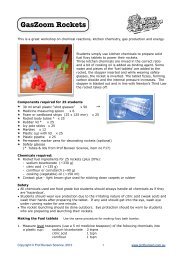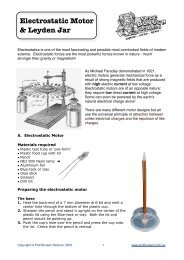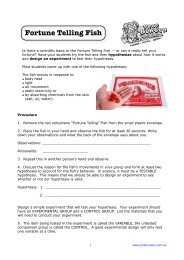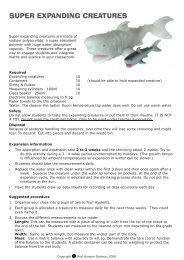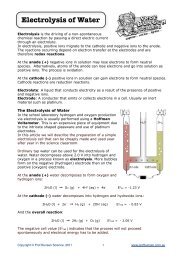Magnetic Accelerator - Prof Bunsen
Magnetic Accelerator - Prof Bunsen
Magnetic Accelerator - Prof Bunsen
- No tags were found...
You also want an ePaper? Increase the reach of your titles
YUMPU automatically turns print PDFs into web optimized ePapers that Google loves.
<strong>Magnetic</strong> <strong>Accelerator</strong>Also known as:The Gaussian Rail Gun or Linear <strong>Magnetic</strong> <strong>Accelerator</strong>Create a simple magnetic accelerator using steel balls and magnets. The demonstration willseem to defy the Laws of Conservation of Energy and Momentum. Alas - no free energyis generated.MaterialsPlastic rail track 1Neodymium magnets 2 or moreSteel balls7 or moreSafety & Maintenance Notes★ The neodymium magnets are very strong and may quickly snap together and pinch skin. Itmay be easier to slide two magnets off each other rather than trying to pull them apart.★ Keep the magnets away from computer disks and credit cards.★ Separate the magnets and steel balls when the kit is stored. The balls can be magnetized.★ We have Zinc-plated the steel chrome balls to reduce corrosion.Procedure1 2 3 4 5 6 710 cm 15 cm1. Starting 10 cm from one end of the track, position the two magnets 15 cm apart.2. Place three steel balls on the downstream side of each magnet.3. Position a single ball to the left of the first set.4. Slowly push the single ball towards the first magnet. Once it gets close enough it will beattracted to the magnet, accelerate towards the magnet and hit the magnet with a generousimpact. Ball 4 is knocked free and moves towards the second stage. The cycle repeats andball 7 flies off the track with an impressive speed!Tip: Position an empty soft drink can close to the end of the track to emphasize the velocityof the ball.The small initial motion of the first ball translates into an “energy gain” for the last ball!Where did the surplus kinetic energy come from?Copyright © <strong>Prof</strong> <strong>Bunsen</strong> Science, 2010www.profbunsen.com.au
Explanation (Summary):1 2 3 4 5 6 71 st stage 2 nd stageNo free energy is generated in the system and energy is still conserved. The key concept is theenergy stored as magnetic potential energy (Ep) in the invisible magnetic field. More magneticpotential energy is acquired by the incoming ball (ball 1) than is required to release the lastball (ball 4) as it is further from the magnet than the incoming ball. The surplus energy istransformed into kinetic energy (and shows as increased velocity) for the released ball.Explanation:✓ When an object is lifted against the earth's gravitational field, it gains gravitational potentialenergy (Ep = mgh, thus Ep ∝ h). In a magnetic field, the steel ball bearing gains magneticpotential energy when it is moved towards the magnet (Ep ∝ 1/r 2 ).✓ When ball 1 enters the magnet's magnetic field it experiences a magnetic force that pulls ittowards the magnet. The increasing magnetic force (as it gets closer) accelerates it alongthe track towards the magnet (Newton II). Most of its magnetic energy is converted intokinetic energy and its maximum velocity is reached at the point of impact with the magnet.(This is difficult to observe as it happens so quickly).✓ The ball collides with the magnet and since energy and momentum have to be conserved inan elastic collision (we assume it is elastic), its energy is imparted to the magnet andstationary ball train. The most distant ball (ball 4) experiences the weakest attraction to themagnet and is easily knocked free. Much less energy is required to knock ball 4 free thanwas acquired by ball 1.✓ The surplus collision energy is imparted to ball 4 as kinetic energy. Ball 4 now enters thesecond stage and the same process is repeated. In each subsequent stage this multiplicationcontinues.Extensions for class discussions / student inquiries‣ The leaving ball is always separated from the magnet by at least one other ball. Why?‣ A third ball downstream moves faster than a second ball downstream? Why?‣ Is there a limit to how many balls can be in the train?‣ Experiment with the number of magnets, the number of steel balls and the separationdistances between the different stages.Then answer:How does the spacing between the magnets affect the speed of the last ball?How does the number of magnets in a stage affect the speed?How does the number of balls in a stage affect the speed?‣ Experiment with smaller and larger leaving ball.‣ Experiment with non-magnetic leaving balls, eg a glass marble. Try it at different positionsin the system.Copyright © <strong>Prof</strong> <strong>Bunsen</strong> Science, 2010www.profbunsen.com.au
‣ Project: Determine the escape velocity in a one magnet system and that of a three magnetsystem. How? Prop two books underneath the track and determine the height and horizontaldistance that the ball will go in its projectile trajectory. Use kinematics to determine theinitial launch speed. (Remember the ball has linear and rotational motion).FAQsThe last ball has a high velocity. The system seems to have gained energy.Is energy conserved in the system?There is no net gain in energy as each time you reset the system, you separate at least oneball from each magnet. In doing this you perform work on the system that is stored in theform of magnetic potential energy. The kinetic energy of the last ball is the sum of the kineticenergies and the magnetic potential energies of all incoming balls minus the potential energiesrequired to release the balls from their magnets (and of course frictional, rotational and heatlosses). It should be equal to the energy you added to the system by separating the magnetsand balls.Ek(last ball) = [ Ek incoming ball + Ep of incoming ball – Ep of leaving ball – E (sound, heat,rotational) ] n stagesWhat is magnetic potential energy (Ep)?This is energy contained in a ferro- or paramagnetic metal due to its position in a magneticfield. It is a function of the distance between the object and the magnet and is proportional to1/r 2 . If we pull a ball that is touching the magnet away from the magnet, then it losespotential magnetic energy. The same happens when we lower a book on a shelf - it losesgravitational potential energy.BEFORE1 2 3 4AFTER1 2 3 4In the BEFORE photo, ball 1 approaches the magnet from “infinity” and has its maximumpotential energy of 1/R 2 just before it hits the magnet (assume its centre is a distance R fromthe magnet and that the magnet has a very small volume). Ball 4 has its centre 5R from themagnet and thus has a potential energy of 1/(25R 2 ). Comparing these two values it becomesevident that ball 4 requires only 1 /25 the energy that ball 1 has gained to escape the magneticfield. It gains 24 /25 of the incoming ball’s energy as kinetic energy!Can stainless steel metal balls be used?No. Most types of stainless steel are not ferro- or paramagnetic so will not gain any magneticpotential energy.March 2011Copyright © <strong>Prof</strong> <strong>Bunsen</strong> Science, 2010www.profbunsen.com.au




